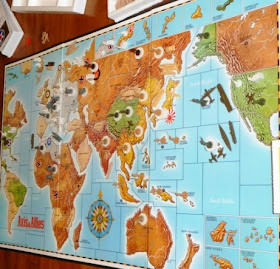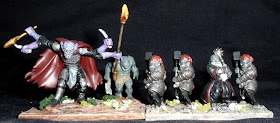Looking at the rules for wands and staves under
EXPLANATION OF MAGICAL ITEMS in the basic
Dungeons & Dragons rulebook, I found something interesting: some of those devices have unlimited uses. From the overview of this class of items:
Wands that have projectiles or rays are considered to do six 6-sided dice of damage and to have 100 charges or projectiles. (emphasis added)
Inverting this sentence, we can conclude that under the Holmes rules, staves don't operate on charges
, since the description just mentions wands. And it makes sense given the nature of those items. The Staff of Healing heals "any number" of people (but the same individual just once per day). The Snake Staff is a melee weapon with a special power, similar to other magic weapons; so is the Staff of Striking. And the Rod of Cancellation is a one-shot device.
That leaves the six wands in blue box basic D&D. Two of these magic items, the Wand of Magic Detection and the Wand of Secret Doors and Trap Detection, don't emit any kind of ray or projectile. The former causes magic items in range to glow, while the latter just gives warning or points to hidden portals or snares. So pursuant to their descriptions from Holmes, neither of these wands use charges to operate.
Of the remaining four devices, the Wand of Fire Balls shoots a projectile and the Wand of Paralyzation emits a ray, so these two wands definitely use charges to function. The rules for the final two wands, however, aren't so definite. The Wand of Fear "can effect all creatures in a cone shaped area emanating from it." The Wand of Cold "creates a cone shaped area of cold the same dimensions as the fear wand." No mention of ray or projectile in either description. However, Holmes describes the Wand of Paralyzation's ray as having the same dimensions as the effect of the Wand of Fear. While the Wand of Cold doesn't mention a ray, its area of effect is also the same dimensions as the fear wand. Therefore, it's safe to conclude that the cold and fear wands also use charges to operate.
This makes sense, as the offensive wands and staves work similarly to mundane weapons--the wands or bows that affect foes at a distance require charges or ammunition, while the items meant for close-in combat don't get used up.
That leaves the two detection wands, which don't use charges. Some dungeon masters might balk at the idea of letting the player characters have limitless means to avoid traps and spot magic, but with a range of 20 feet they're both pretty limited. If you still think it's too powerful, rule that it takes a full turn to conduct a search using a detection wand--a party taking one turn to cover 20 feet of dungeon corridor will attract a lot of wandering monsters. And if that device is still too unbalancing for your game, just think about what the Thieves Guild or the local wizard might do once they learn such an item is in the hands of the adventurers ...





















































